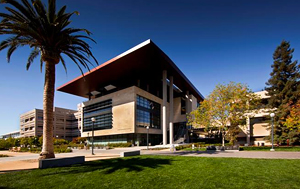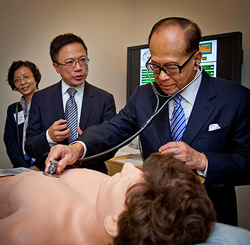September 29, 2010 - By Ruthann Richter

The Li Ka Shing Center for Learning and Knowledge was officially dedicated on September 29, 2010.
The Stanford University School of Medicine today begins a new era with the dedication of the Li Ka Shing Center for Learning and Knowledge, expected to dramatically change the way in which physicians are trained.
The five-story building with a diverse array of sophisticated technologies - including one of the largest and most advanced simulation facilities in the country and a high-end video capture system - represents the latest in medical education. It is designed for interactive, experiential and team-based approaches to learning for people at all levels, from incoming medical students to experienced clinicians.
Speaking at today's dedication ceremony, Stanford University President John Hennessy, PhD, said, "The Li Ka Shing Center for Learning and Knowledge exemplifies the future of medical education. Positioned in the center of the Stanford University School of Medicine, the LKSC builds on our strengths in the biomedical sciences and related disciplines. Its use of cutting-edge technology advances a new model for educating doctors and scientists in this century and will allow us to make even greater contributions to society. We owe a special thanks to Mr. Li Ka-shing for his visionary philanthropy, as well as to the many other donors whose generosity has made this building possible."
Hong Kong entrepreneur and global philanthropist Li Ka-shing, a longtime friend of Stanford, is the building's major benefactor. He was attracted to the project because of his continuing relationship with the university and its dedication to the highest standards and innovation in health-care sciences, as well as his belief that the new center will contribute to transformative change in medicine through leading-edge education that reaches beyond traditional health-care training to include knowledge and learning from many other disciplines.

President John Hennessy of Stanford University and Dean Philip Pizzo of the medical school laugh with Li Ka-shing as he presents the school with an ancient Chinese crib sheet, used by students in the 18th and 19th centuries to cheat on imperial exams. The presentation was made during the dedication ceremonies of the new Li Ka Shing Center for Learning and Knowledge at the Stanford University School of Medicine.
"Stanford has a proud and honored history in medical education, research and delivery," Mr. Li said at today's dedication ceremonies. "This new center opens an exciting and even futuristic multi-dimensional learning experience by creating a synergy of interdisciplinary programs to provide virtual training and tools for students and practitioners to receive the best information and knowledge across an infinite array of academic platforms. There is nothing like it in the world, and we are pleased to be a part of this historic day."
Mr. Li, who traveled from Hong Kong for the building's dedication, is the chairman of Cheung Kong (Holdings) Limited and Hutchison Whampoa Limited, two of Asia's most prominent companies, with more than 240,000 employees in 54 countries.
He is also chairman of the Li Ka Shing Foundation and has pledged one-third of his assets to philanthropy. To date, Mr. Li has granted more than $1.45 billion to projects worldwide, including support for the new education center, and he maintains an endowment of $7 billion in the foundation. The Li Ka Shing Center for Learning and Knowledge is the foundation's third major project with Stanford, which he has been associated with since 1983. To date, Mr. Li has contributed more than $37 million to support its medical and research programs.
The new 120,000-square-foot center faces Campus Drive, overlooking an expansive, park-like front lawn and creating a welcoming entrance to the school. Its sweeping, red-trimmed roof and limestone exterior echo the architecture of the university's main quadrangle. The building sits at the crossroads of the medical and the university campuses and is expected to be the focus of many multidisciplinary efforts.
"I believe this building is truly transformative, that it will recalibrate the way medical education is conducted and will be enormously attractive to our community locally, nationally and globally," said Philip Pizzo, MD, dean of the School of Medicine.

Li Ka-shing examines "Harvey," a cardiopulmonary patient simulator in the the Li Ka Shing Center for Learning and Knowledge at the Stanford University School of Medicine. The new five-story building is one of the most technologically advanced medical training centers in the world for immersive and simulation-based learning.
The building, which welcomed its first students Aug. 16, will be the hub for all of the school's educational activities. Its ground floor houses the 28,000-square-foot Hon Mai and Joseph Goodman Center for Simulation and Immersive Learning, a world-class center that is one of the largest and most comprehensive facilities of its kind, according to David Gaba, MD, associate dean for immersive and simulation-based learning.
"In its fully simulated hospital, trainees can use programmable mannequins that bleed, breathe, blink and talk to test their skills in managing virtually any kind of medical condition, from heart attacks and severe allergic reactions to catastrophic hemorrhage and obstetric complications," said Gaba, who pioneered the first medical modern mannequin-based simulator 25 years ago.
The hospital includes a fully equipped operating room and a multi-bay emergency room, where teams can test their split-second responses to medical crises or simulate a mass casualty emergency, among other activities, he said. Trainees also can use individual simulation devices to acquire or test psychomotor skills in doing hands-on surgery; conduct a prostate exam; or learn how to diagnosis cardiac and lung problems on a specialized mannequin with lifelike heart sounds, pulses, jugular vein distention and other physical signs.
The simulation center sets aside a space for the use of online "virtual worlds," and a large room where Gaba and his colleagues are planning to develop a virtual-reality environment that would be a first step toward the Star Trek holodeck, where trainees can treat virtual patients and collaborate with virtual co-workers.
The building also has classic-looking classrooms and both large and small meeting spaces, with an added bonus: Every part of the building is equipped with the ability to capture activities on video and send it throughout the building. The facility has more technology than any other building on campus, with $9 million in audiovisual equipment and a high-end wiring system.
That means, for instance, that people in a second-floor classroom could observe a scenario under way in the simulation center, even pausing to discuss what steps to advise those in the simulation to take next.
The entire building is geared for maximum flexibility, to adapt to the school's changing curriculum. For instance, the 350-person conference room on the second floor can be set up as a tiered lecture hall with stadium-style seating, as a full banquet facility or as a standard conference room with 5-foot rectangular tables.
The building replaces the school's 50-year-old education and library facilities, constructed when the school moved from San Francisco to Palo Alto. Those facilities will be maintained and adapted for research and administrative uses.
The building was designed by the international architecture firm, NBBJ, a global architecture, planning and design firm that helps companies and organizations create innovative places. The firm has planned and designed science facilities for many of the world's leading research institutions, including the Wellcome Trust Sanger Institute and the Novartis Research Foundation.
The total cost of the building is $90.2 million, financed through private philanthropy, debt and school resources.
About Stanford Medicine
Stanford Medicine is an integrated academic health system comprising the Stanford School of Medicine and adult and pediatric health care delivery systems. Together, they harness the full potential of biomedicine through collaborative research, education and clinical care for patients. For more information, please visit med.stanford.edu.